How electrification is heating up race to meet emissions targets
13 September 2021
The move to electric-driven access equipment seems inevitable but the journey is not necessarily straightforward.
Climate change has now been recognised as an international emergency, rather than the imminent concern we have all got used to over the last decade.
The construction sector and those that regulate it have been aware of the issues for many years and sought to address the situation through increasingly strict emission regulations. While reducing those diesel-related emissions is a vital goal, the realisation that combustion-based power must have a limited future has led to an increasingly greater concentration on hybrid and battery technologies, along with other green options, like hydrogen, which is becoming a very real alternative.
A move towards hydrogen has been in the scope of OEMs for many years but there is now an acceleration in the marketplace for this power type. For example, Manitou has vowed to develop hydrogen for its telehandler equipment and thinks it and lithium batteries can happily co-exist for its powered access products.
Lithium to play a key role
Of all the construction-related sectors, access lends itself to the acceleration of green energy, thanks to the equipment being, in many cases smaller, in comparison to other construction equipment and its regular use in indoor settings and environmentally-sensitive areas.
Indeed, electric access equipment is nothing new and lead acid batteries have been powering slab scissors for decades. While lithium-ion is dubbed as the future, traditional lead acid will play a significant role, thanks to its relatively low cost and widely established presence in the international market.
For example, Sinoboom has extended its partnership with Discover Battery, under which the manufacturer’s range of boom, scissor and vertical mast lifts will be supplied with Discover’s non-spillable Dry Cell AGM batteries, as standard.
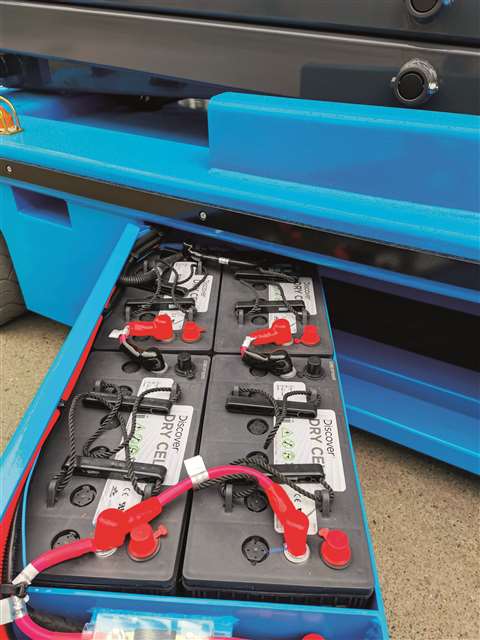 A Sinoboom scissor lift fitted with Discover batteries.
A Sinoboom scissor lift fitted with Discover batteries.
The new partnership also extends to Sinoboom’s latest addition of environmentally-friendly platforms, launched at bauma China last November. This will see Discover providing batteries for the new 40ft 1218RE electric rough terrain scissor lift, as well as the 60ft electric AB18EJ and hybrid AB18HJ articulating boom lifts.
Alexander Marotz, Discover Battery product and business development manager for Europe, says, “We are continually working with OEMs, rental companies and end users to ensure our Dry Cell battery technology not only contributes towards sustainability ambitions but also improves total cost of ownership and overall user experience.”
Nevertheless, lithium is increasingly seen as the only feasible long-term solution, in terms of batteries, for rough terrain equipment access equipment.
Manitou’s five year emission strategy
In the next five years 40% of all the equipment that Manitou produces, across its product ranges of telehandlers, MEWPs, skid steers, forklifts and wheel loaders, will be low emission equipment. In the MEWP segment, all new projects will be based around the development of electric-powered models and lithium batteries are set to take over from lead acid in the manufacturer’s 100%-electric Oxygen series, first launched at Bauma in 2019.
Michel Denis, Manitou CEO, explains, “We will continue to offer the existing [diesel] range. If you want a [diesel] boom today or tomorrow then we will provide it, and for 10 or 15 years, however long the need for diesel remains. But we will not spend any more in development. All new models will be 100% electric.”
Electrifying its entire telehandler range is significantly more complex than doing so across the existing rough terrian MEWP series. While the company has promised to start with the rotating MRT range, the process will not be immediate. In terms of hydrogen, the company is in partnership with specialists in France, which will see its first hydrogen-powered telehandler launched in 2023.
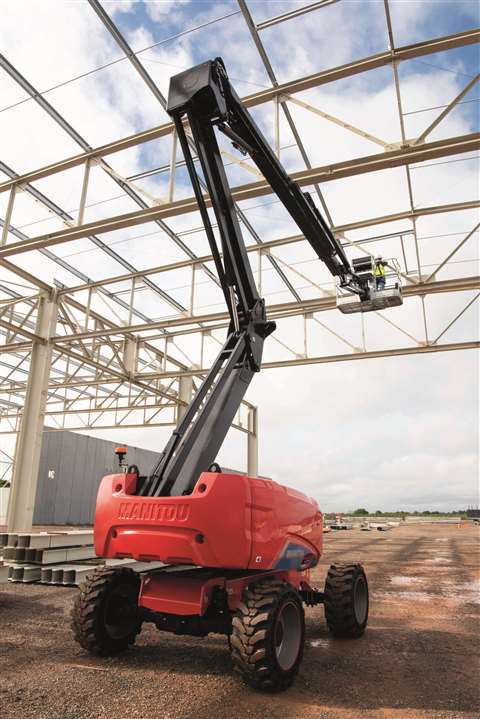 Manitou’s electric RTs will use lithium-ion batteries in the future.
Manitou’s electric RTs will use lithium-ion batteries in the future.
Haulotte has also confirmed a lithium route. The 100%-electric Pulseo range, launched with a 20m RT boom lift in 2017, and added to last year with RT scissor lifts, also started out being powered by lead acid batteries – a situation that is set to change. Alexandre Saubot, CEO of Haullote, says, “We are working on lithium for the future. But, at the end of the day, we are at the beginning of a longer journey.
“We are a small player in that chain. We have a strong desire to secure zero emissions but we are following technology. We watch where the world is leading what is possible and requested in the market today. ”
JLG highlights growing awareness
Barry Lindsey, JLG’s director of engineering - Europe, says in the past, customers had reservations when it came to lithium batteries, around safety and cost but there has been marked change in outlook. “More and more people understand it from total cost of ownership point of view. They fit into a machine for life, they are robust, and they are not damaged by low charging or no charging at all. Lithium is becoming a real opportunity.”
In February of this year, JLG’s parent company, Oshkosh Corp., announced an investment into Microvast, a developer of lithium ion battery technology for commercial and specialty electric vehicles.
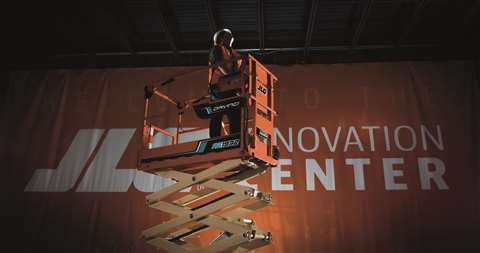 JLG all-electric AE1932 DaVinci Scissor Lift.
JLG all-electric AE1932 DaVinci Scissor Lift.
Oshkosh agreed to make a $25 million private investment in public equity in Microvast, highlighting future battery collaboration and integration.
The new partnership will continue to strengthen the development of electrified solutions across the JLG product line, including boom lifts, scissor lifts, low level access, vertical mast lifts, stock and order picker lifts, towable lifts and telehandlers.
Frank Nerenhausen, Oshkosh executive vice president and president of JLG Industries, says the company is focused on electrification and the delivery of sustainable technologies without a compromise to performance. “We believe advancing battery technology is crucial to striking this balance.”JLG’s most recent electric product introduction was the industry’s first all-electric model, including drive systems, the AE 1932 DaVinci scissor lift.
“Our new DaVinci all electric lift represents the future of electrification –every component is optimised to deliver premium performance and value to the customer,” adds Nerenhausen.
On the subject of lithium-ion-powered RT equipment, specifically boom lifts, Barrie Lindsey says, “I don’t see it happening large scale in the next year or 18 months but as we produce more equipment that is seen as being reliable and of value to the rental companies, then I think more and more people will swap over.”
As Lindsey adds, once that tipping point comes into focus, the typical rental company will become hesitant about investing in anything else but electric equipment. “In a few years’ time, they will question their cap ex budgets around diesel powered machines. They will ask, ‘what is the residual value of that diesel equipment going to be?’”
Electrification challenges
However, challenges do remain around electrification and lithium. Kai Schliephake, managing director of German rental company cooperative Partnerlift, believes the future will see us on a different path to lithium, which will ultimately be driven by the car industry.
“I am sure there are lots of metal elements that we are not thinking about today. Lithium has a very high energy density. There is no need for this high density. There could be a new battery solution that fits much better with our industry.”
Schliephake adds, “I believe we are just at the beginning of a journey and we will see new, better types [of power sources] in a few years…I’m not sure we have found the best battery package at the moment”.
Certainly, for rental companies, the challenges stertch beyond the equipment istself. Martin Sebestyén, head of rental and fleet management at Germany-based Zeppelin Rental, points out, “When it comes to the adoption of electric RT equipment, an important factor will be providing charging capabilities across all worksites.”
Sebestyén admitted, “This is still an issue. You have to have all functionalities available onsite so that you can reach out to all the booms there.”
Nevertheless, the company is focusing heavily on in the immediate future is electric and hybrid equipment. Currently, 90% of its scissor lifts are electric and 70% of the telescopic boom lifts are either electric or hybrid-powered.
He explained that those percentages are set to increase, “The heavy machines are still diesel because this is the demand but for light equipment, which you can use inside and outside, we try to order just electric for the future.”
Hybrid technology solutions
Until that full-electric day comes, there remains a view in the industry that hybrid technology is the ideal solution for rough terrain equipment. Genie is one of the companies to support that idea, which is why the manufacturer is committed to its hybrid FE boom lift range for its provision of environmentally-friendly equipment.
As Sean Larin, Genie’s product manager, explains, “Hybrid certainly is another trend. Globally, jobsite regulations have become increasingly more stringent, requiring quiet equipment with lower or no emissions. At the same time, there has an increased need to work in more places, with large jobsites requiring machines that can work both outdoors and indoors.
“These factors are combined with technological advances that have improved performance of hybrid and electric machines while also reducing the costs associated with them. Together, this certainly helps explain the rising popularity of hybrid technology. Genie is addressing this need with our FE hybrid boom lifts.”
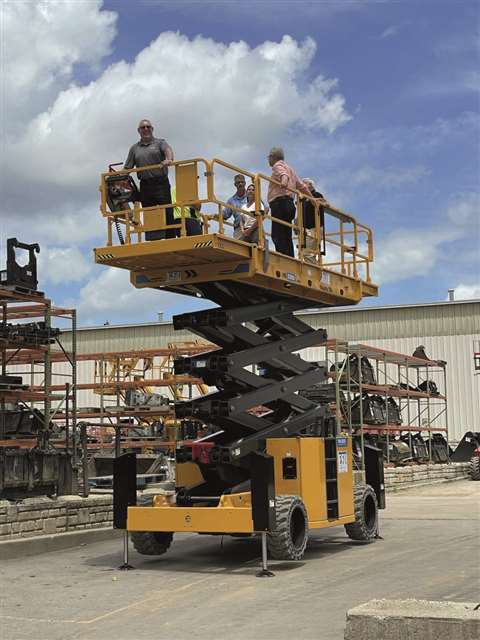 EFI’s new fully electric scissor from Haulotte. EFI’s new fully electric scissor from Haulotte.
PULSEO FOR USATennessee-based Equipment Finders (EFI) has purchased two fully electric Pulseo HS5390 E PRO rough terrain scissors from Haulotte, which were first launched earlier this year. “The new Pulseo electric scissors are perfect for our customers who will be utilising them at huge data centres and storage buildings,” said Scott Hatcher, EFI’s owner. “They offer a remarkable load capacity and embed Haulotte latest’s innovations. This zero-emission lift can also be used indoors.” The HS5390 E PRO features a working height of 58ft, 6 inches and a platform capacity of 1,654 pounds. When extended, the platform offers 19ft, 4 inches of working length and 6ft, 2 inches of width. The fully electric scissor lift can be driven while at height (up to 42ft, 8 inches) and features gradeability of 40%. A 48V battery pack can deliver a full day of work and has three charging options. An optional three-phase accelerated charger provides an 80% charge in three hours. A 5.5kW removable range extender combustion engine can be used to rapidly recharge the batteries while the machine is operational. |
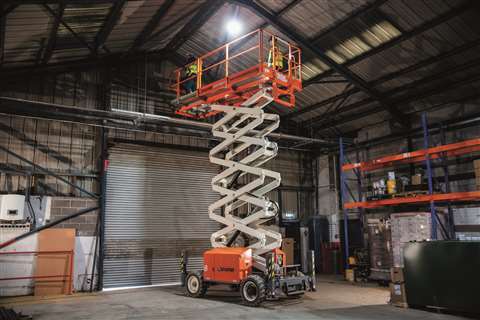 Snorkel’s electric rough terrain S3970RTE. Snorkel’s electric rough terrain S3970RTE.
Snorkel ramps up lithium-ion battery techFor 2021, Snorkel is expanding its lithium-ion battery technology to its two ultra-narrow 1.45m width compact rough terrain scissor lift models. Branded as the S2255RTE and S2755RTE, these models will enter UK and New Zealand production in early 2021. Suitable for working in confined spaces, they are ideal for cladding applications between densely built industrial units, which, due to width restrictions, would previously have been accessed with scaffolding. The S2255RTE and S2755RTE also come equipped as standard with 11.5kW of lithium-ion battery power (2 x 5.75kW battery systems) and can be optioned with an additional 5.75kW battery system if required. |
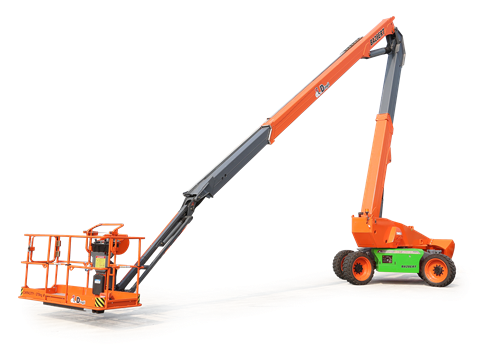 Dingli’s all-electric BA28ERT boom lift. Dingli’s all-electric BA28ERT boom lift.
Dingli expands with scissor and boom liftsDingli has launched two large compact electric rough terrain scissor lifts to top its range, and has been expanding its wider electric boom range. The 28m and 32m working height JCPT2814DC and JCPT3214DC models are equipped with 80V/520Ah high capacity lithium battery packs. Another key feature is their narrow width, of 1.39m. Both models provide a maximum load capacity of 600kg for two workers and can drive at full height, and are equipped with four wheel direct electric drive, as well as U-turn and crab steering. Gradeability is 25% and maximum working slope level 1%. In addition, there is a 1.9m extension platform on both models; while the JCPT2814DC has a 5.08m platform length and the JCPT3214DC has a 5.85m platform length. The all-electric BA28ERT boom lift has a working height of 28.1m and a maximum load in the basket of 250kg. The whole machine adopts pure electric drive and is equipped with 80V520Ah maintenance-free high-capacity lithium battery pack with quick charge of 1.5 hours. |
Hinowa launches TelecrawlerThe latest equipment from Hinowa is the TeleCrawler TC13 N and TC13 S. The N (narrow) version was launched in April 2020, while the S (standard) version was presented earlier this year. 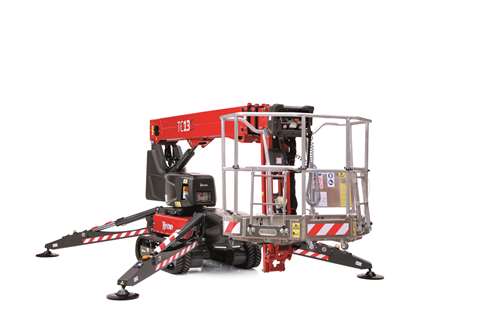 Hinowa’s TeleCrawler. Hinowa’s TeleCrawler.
The unique feature of Hinowa’s first telescopic tracked platform is the all-electric drive. The undercarriage is constructed by using electric traction motors which allow it to travel on electric power only, without the use of hydraulic oil. It’s the first time a spider lift has had direct electric drive. In the fourth quarter of 2021 Hinowa will follow it up with the launch of the second model in the range, the TeleCrawler TC22. It will also be in two versions, the TC22N and TC22S. The lightweight model, at less than 3 tonnes, can reach a working height of 22m and has an outreach up to 12.5m. |
Dana solidifies e-mobility optionsDana has been among the companies at the forefront of product development of both conventional and e-mobility technologies. The company launched an integrated system for electric boom and scissor lifts with working heights above 6m. The complete package incorporates Spicer Torque-Hub wheel drives, low-voltage internal permanent magnet motors, inverters, slew drives, pump-motor, system pumps, proportional valves, and electronic control units. Jeroen Decleer, general manager and vice president of mobile Europe for Off-Highway Drive and Motion Systems, says, “We are expanding our presence with two major investments in India and China – but there is also a strong commitment to serve our North American customers using Dana’s expanded footprint and electrification know-how coming from Dana’s recent Brevini, Nordresa, Oerlikon Drive Systems, Pi Innovo, Rational Motion, and TM4 strategic acquisitions.” 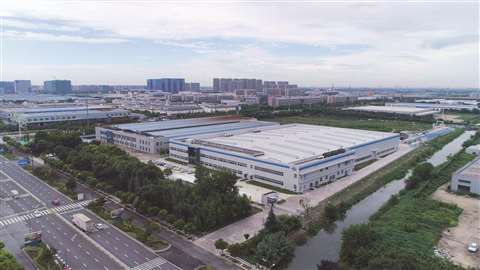 Dana’s manufacturing facilities in Yancheng China. Dana’s manufacturing facilities in Yancheng China.
“We are putting up a new plant in Chakan, Pune, (India), which is for our traditional drivetrains, but it is also a state-of-the-art facility in terms of electrification. There is a growing demand in Asian markets for traditional vehicles. For instance, MEWPs are taking off at a pace we haven’t seen in the US or in Europe. It was below 100,000 a year before, and now we are seeing that doubling every couple of years. “China’s changing. The number of vehicles they use per capita is still far below what we are used to in our more mature markets, so they are doing some catch-up. And they are catching up in the right way, investing also in the latest technology. “In Europe, we see our investments pushing into certain areas where we have a leadership position – compact wheel loaders, telehandlers and of course ag equipment.” |
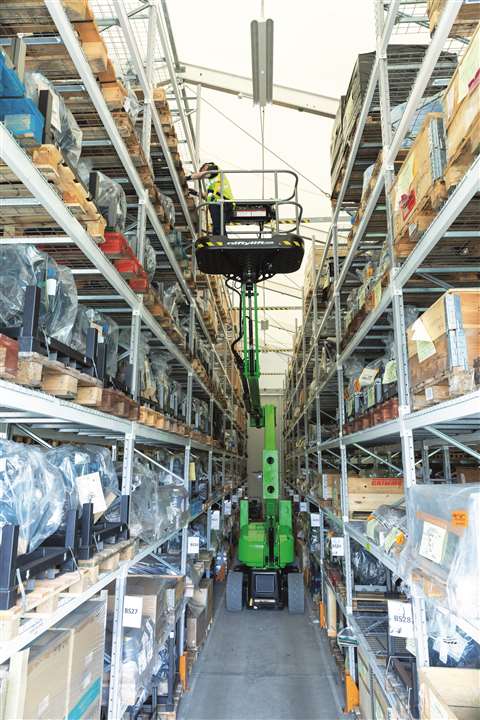 The HVO fuel will now be used for Speedy Powered Access’ entire equipment fleet, including the HR15N from Niftylift. The HVO fuel will now be used for Speedy Powered Access’ entire equipment fleet, including the HR15N from Niftylift.
Speedy HVO at the doubleThe HVO fuel will now be used for Speedy Powered Access’ entire equipment fleet, including the HR15N from Niftylift. Moving away from the strict subject of hybrid and electric-powered equipment, but demonstrating the efforts being made in the name of sustainability, UK-based equipment rental company Speedy has announced that its powered access division will now use hydrotreated vegetable oil (HVO) fuel as standard for its equipment. The company, which announced Green D+ enhanced HVO as its preferred fuel in September of 2020, said it expects use of the diesel alternative to save around 225 tonnes of CO2 a year. Producing emission levels of up to 90% lower than traditional red diesel, the green fuel will be used across Speedy’s 11 specialist powered access service centres, at “no additional cost to customers”. Andy Briggs, managing director at Speedy Powered Access, said, “Leading the market to drive positive change is central to our Energise strategy, which aims to minimise the environmental impact of Speedy and the wider industry by increasing access to sustainable solutions like HVO.” Said to be the first equipment rental business in the UK to switch, the rollout of the biofuel follows the completion of a two-year trial and forms part of its net-zero carbon before 2050 ambition. |
STAY CONNECTED



Receive the information you need when you need it through our world-leading magazines, newsletters and daily briefings.
CONNECT WITH THE TEAM








